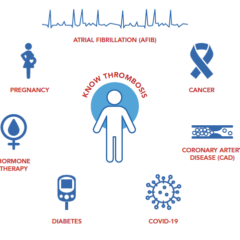Published on
Can Diabetes Increase Your Risk of Blood Clots?
Diabetes can affect your health in many ways, including increasing your risk of blood clots. There are two classifications of diabetes: type 1 and type 2. In type 1 diabetes, the immune system attacks and destroys the cells in the pancreas that make insulin. In type 2 diabetes, your body either doesn’t make enough insulin or can’t use it properly. Both types can increase the risk of blood clots. But type 2 is often linked to obesity and high cholesterol—risk factors that make clots more likely.
Blood Clot Basics
A blood clot forms when blood thickens and clumps together inside a blood vessel, blocking blood flow. Clots can be helpful if you have a cut or injury because they stop bleeding. Sometimes, they can form when they’re not needed or don’t dissolve properly.
A blood clot in a vein is called a venous thromboembolism (VTE). When it forms in deep veins, it’s called deep vein thrombosis (DVT). If the clot breaks off and travels to the lungs, it’s a pulmonary embolism (PE).
How Diabetes Can Lead to Blood Clots
People with diabetes have a higher risk of getting blood clots for several reasons.
Changes in consistency of blood
People with diabetes often have higher levels of a protein called fibrinogen. This protein makes blood stickier and causes red blood cells to clump together. Blood flow becomes slow and makes the blood more likely to clot.
Changes in clotting and platelet activation
Diabetes affects the clotting process by creating an environment in the body where clots form more easily and breakdown less easily. These changes occur because the proteins responsible for clotting, called coagulation factors, change in both quantity and function in people with diabetes. High blood sugar also activates the clotting system, further increasing the risk of clots.
In diabetes, platelets also become stickier and more active, clumping together and forming clots more easily. As platelets stick together, your body makes more of them, which increases their activity and can lead to even more clots.
Blood vessel damage
The cells inside your blood vessels help control blood flow by making the vessels wider or narrower. They also help stop clots and control swelling. But when things go wrong, these cells can cause swelling and clots instead of protecting you.
High blood sugar puts further stress on the body and causes harmful substances to build up. These substances can damage cells, cause inflammation, and increase the risk of blood clots.
The Risk of Recurrence
If you have diabetes, the chances of having another blood clot, like DVT, are higher, even without other health problems. If you also have other conditions like high blood pressure or high cholesterol, the risk is even greater. Managing your diabetes is important to help reduce the chances of recurrent clots.
Managing Blood Clots When You Have Diabetes
Lifestyle changes like exercise and a healthy diet can help keep high blood sugars under control. Medications also play a key role in reducing the risk of clots for people with diabetes.
- Blood thinners include medicines like aspirin or clopidogrel (Plavix)
- Anticoagulants, also known as blood thinners, include medicines like warfarin and direct oral anticoagulants (DOACs, such as apixaban and rivaroxaban)
- Cholesterol-lowering drugs, like statins, help reduce inflammation in the blood vessels
- Metformin—and other medicines used to lower blood sugar—can also lower the risk of clots forming
Managing diabetes isn’t just about controlling blood sugar – it’s also about addressing other health risks, like high blood pressure and cholesterol, which can increase the risk of having a blood clot. Whether you have type 1 or type 2 diabetes, keeping your whole body healthy is key to reducing complications and staying well.
*Originally published in The Beat — October 2024. Read the full newsletter here.
References
Batten L, Sathyapalan T, Palmer TM. Molecular mechanisms linking diabetes with increased risk of thrombosis. Int. J. Mol. 2023; 24(24):17465. https://doi.org/10.3390/ijms242417465
Diabetes mellitus (DM). Merck Manual. https://www.merckmanuals.com/home/hormonal-and-metabolic-disorders/diabetes-mellitus-dm-and-disorders-of-blood-sugar-metabolism/diabetes-mellitus-dm. Accessed September 30, 2024.
How does blood clot? National Heart, Lung, and Blood Institute. https://www.nhlbi.nih.gov/health/clotting-disorders/how-blood-clots. Accessed on September 30, 2024.
Li X, Weber NC, Cohn DM, et al. Effects of hyperglycemia and diabetes mellitus on coagulation and hemostasis. J Clin Med. 2021;10(11):2419. doi:10.3390/jcm10112419
Piazza G, Goldhaber SZ, Kroll A, et al. Venous thromboembolism in patients with diabetes mellitus. Am J Med. 2012;125(7):709-716. doi:10.1016/j.amjmed.2011.12.004
Samad F, Ruf W. Inflammation, obesity, and thrombosis. Blood. 2013;122(20):3415-3422. https://doi.org/10.1182/blood-2013-05-427708
Vaidya AR, Wolska N, Vara D, Mailer RK, Schröder K, Pula G. Diabetes and Thrombosis: A central role for vascular oxidative stress. Antioxidants (Basel). 2021;10(5):706. doi:10.3390/antiox10050706


